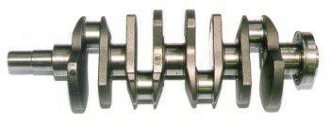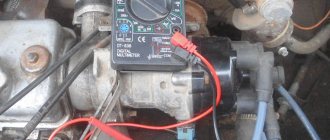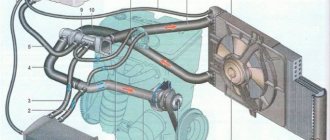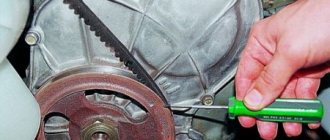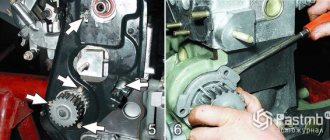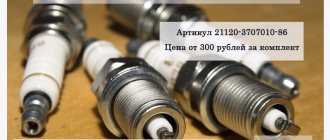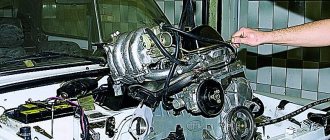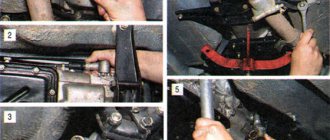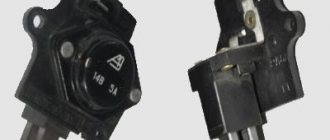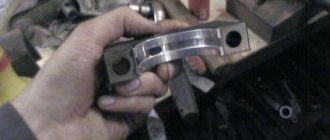The connecting rod or crankshaft bearings are plain bearings, which are additionally supplied with engine oil from the engine lubrication system. This solution allows loaded parts to move freely and easily, while achieving a pairing of loaded elements in which there are no gaps or backlashes. Such sliding bearings should be understood as a high-strength steel sheet of a special shape, on which a special anti-friction coating is applied.
We also recommend reading the article on how to correctly understand that the engine is knocking or knocking. From this article you will learn about the various causes of knocking in the engine and methods for diagnosing them.
Rotating connecting rod bearings or crankshaft bearings is a serious problem that must be corrected immediately. Most often, the driver becomes aware of a problem due to the appearance of a distinct, characteristic connecting rod knock or knock of the engine crankshaft. Further operation of the internal combustion engine in which the liner has been rotated is highly not recommended, since breakdowns of this kind cause significant damage not only to the associated parts, but also to other components of the power unit. Next we will talk about what to do if the connecting rod bearing has turned, what the cause and consequences of such a breakdown could be.
Turned the connecting rod bearing consequences and repairs
Let's start with the fact that turning the connecting rod bearings of the engine when a breakdown is detected in a timely manner is a less serious problem compared to turning the crankshaft main bearings.
If the problem is detected late, then the consequences for the internal combustion engine may be different. It happens that after cranking the connecting rod bearing, the engine may require an expensive overhaul. A common situation is when a cranked connecting rod bearing is simply replaced with a new one and the engine continues to run. Note that it is not recommended to do this due to the fact that the service life of the connecting rod-crankshaft journal coupled pair repaired in this way can be greatly reduced (by 60-70%). A more acceptable option is considered to be the approach of changing the connecting rod in which the liner was turned. Also, the connecting rod often needs to be replaced due to the fact that as a result of turning the liner, the connecting rod lock breaks. The optimal method of repair is considered to be boring the crankshaft and replacing the bearings/rods.
Grinding the crankshaft after turning the liner is usually a necessary operation, since scuffs appear on the journal. After disassembling the engine, the crankshaft must be measured, after which it is bored, taking into account the subsequent installation of new bearings of repair size. This is the only way to achieve the required condition of the surfaces and the correct tension of the liner after installation.
Mechanical wear
The first reason why the main and connecting rod bearings are replaced when repairing an engine is wear. Parts wear out due to mechanical loads. Many people try to save their earbuds, but it is useless. Physics is involved here, and physical processes cannot work any other way. Wear and tear is inevitable. The anti-friction layer on the liner wears off over time. This leads to free movement of the crankshaft. Backlashes appear. As a result, the oil pressure decreases, quite significantly. On most engines that are highly reliable, if the liner turns, this indicates their wear.
How to determine a breakdown
Communities VAZ Repair and Modification Blog Cleaning the throttle valve of a VAZ 2115. Faulty lambda probe oxygen sensor
When the main bearings are turned, the crankshaft immediately fails and in the case of the connecting rod bearings turning, the connecting rod itself, the crankshaft, and also the cylinder block will fail. As a result, the car owner can only benefit from a major engine repair. This failure can be determined. There are some signs of loose liners. One of them is a characteristic metallic knock throughout the engine.
It does not stop even at idle, and with increasing load it knocks even more intensely. Another sign is low oil pressure. If the engine is cold, then there may be no sounds. If the situation is hopeless, the engine will stall, and it can only be revived by repair.
What are crankshaft connecting rod bearings?
Communities Anticorrosive Blog TREATING THE BOTTOM WITH CONSTRUCTION MASTIC
As has already become clear from the preface, the crankshaft connecting rod bearings are the sliding bearings of the crankshaft connecting rods, which give it rotational movements. Rotation occurs as a result of microexplosions in the combustion chambers of internal combustion engine cylinders. This automotive system constantly operates under conditions of high speeds and extreme loads. Therefore, there is an urgent need to minimize the friction of parts, because otherwise, instant engine failure may occur. To most completely reduce the friction force between the parts of an internal combustion engine, they are coated with a special oily thin film.
It is provided thanks to the automotive engine lubrication system. The film appears only when the oil is under sufficiently strong pressure. The crankshaft bearings and journal are also separated by such a microscopic layer of oil. It is thanks to such protection that the friction force is minimized as much as possible. From this we can conclude that the crankshaft connecting rod bearings are certain protective elements that increase the service life of the most important part of the car engine. Let's first mention that there are two categories: main and connecting rod.
Connecting rod type bearings are located between the connecting rods and the crankshaft journals. The main ones are similar to the first ones in their operational purpose, but are located on the crankshaft in the place where it passes through the housing of the internal combustion engine. The crankshaft bearings have different internal diameters. This depends on the type of engines for which they are manufactured. Repair crankshaft liners differ from each other and, of course, differ from new ones that are installed on a car that has just rolled off the assembly line. The crankshaft repair liners differ from each other only by a mark that is a multiple of 0.25 mm. That is, their size range in terms of internal diameter looks approximately as follows: 0.25; 0.5; 0.75; 1 mm, etc.
Prevention methods
As mentioned above, partial failure of the liners entails increased wear of the engine, and in particular, its lubrication system. Therefore, in order to prevent such a situation, it makes sense to carry out periodic preventive measures. So, first of all, you need to use the engine oil recommended by the car manufacturer. This is especially true for its viscosity. You should not buy very cheap oil, since there is a high probability that it will contain abrasive particles that negatively affect the engine as a whole, and the liners in particular.
It is also worth periodically checking engine parts, their condition, geometry, and cleanliness. When performing repair work, you must always ensure that no dirt gets into the engine and/or lubrication system (oil). There is a so-called “golden rule” for mechanics, which states that a gap of 0.03 mm more is better than a gap of 0.01 mm less. In this case, the liner is guaranteed not to fail, not melt or rattle. Keep your car's engine in good condition and it will serve you for many years.
It is better not to wait until the light on the dashboard lights up indicating low oil pressure. Ideally, you should periodically check the pressure value yourself or at a car service center. After all, the oiler light turns on (that is, the emergency sensor is triggered) only in extreme cases, when the pressure has dropped to critical. It is better to avoid this, especially on engines with significant mileage.
Conclusion
It is necessary to periodically check the condition of the liners, since these seemingly insignificant details can lead to major problems with the engine oil system, thereby significantly reducing its service life. And the sooner the breakdown can be identified and repaired, the lower the costs the car owner will have to face in the future to carry out engine repairs. The replacement procedure can be carried out either independently or at a service station. However, if you decide to carry out the repair yourself, then you must be 100% sure that you will be able to complete the job, since replacement involves a large amount of both dismantling and installation work.
- Why does the connecting rod bearings turn?
- What are crankshaft connecting rod bearings?
- Reasons for turning the crankshaft connecting rod bearings
- How to install liners on the crankshaft - procedure
You can often hear interesting phrases in dialogues between drivers and mechanics - both new and experienced -: “The engine is knocking!” or “The insert was spun!” Well, of course, everyone understands that the conversation turned to an emergency situation in the internal combustion engine, or rather to the fact that the main or connecting rod bearings of the crankshaft have failed. This is a very serious incident that happens to the engine quite often, and low-quality engine oil is usually blamed for all this. They say that the oil was purchased from an unverified manufacturer, which is why such a nuisance occurred. But the truth is, there are many reasons not directly related to engine oil that cause crankshaft bearings to fail.
Reasons for rotating liners
Communities Garage Equipment and Tools Blog Spring Tensioner
So, the crankshaft is a part that operates in harsh conditions and has to withstand enormous loads in extreme temperatures. In order for the mechanism to be securely held on the axis and to ensure the correct operation of the entire crank mechanism, liners are needed. The journals on the shaft act as an internal race. Inserts - as external ones. The internal combustion engine block has channels for supplying lubricant under pressure. Due to the oil film that envelops the liners, the crankshaft can rotate. Why do car owners encounter situations where the crankshaft liners have turned in the engine? There are several possible reasons. Let's look at them below.
Features of operation
During engine operation, the liners are subject to constant loads due to mutual friction of these parts. Therefore, the installation of the main bearings must be carried out with reliable fixation to avoid their displacement by the rotating crankshaft. To achieve this, measures are taken:
- Firstly, they take into account the characteristics of friction of the parts in question, which manifests itself when they slide against each other under load. Its value is determined by the friction coefficient and the magnitude of the load on the interacting parts. Therefore, to ensure reliable retention of the liners, the impact of the crankshaft on them should be reduced. For this purpose, the coefficient of friction is reduced by using antifriction materials that are applied to the surface of the liners.
- Secondly, the main liners are mechanically held in place. Two methods are used for this. These elements are installed with interference specified structurally. In addition, on each of them there is an additional element called a tendril, which also serves for holding.
Connecting rod bearing - what is it?
There is one very highly loaded part in an internal combustion engine. The element is not mounted on traditional bearings. Due to the design features used, the design of these very parts may be different. But the constant improvement of engines has led to the fact that a sheet of steel coated with a special anti-friction layer is now used. This is the connecting rod bearing. These elements are installed in special places - beds. The inserts are fixed. The need to fix these parts is due to the fact that they have holes for oil movement. They must match those in bed. Also, by means of fixation, friction is ensured on special surfaces designed for this purpose. The connecting rod liner is a kind of protective element, thanks to which the service life of the crankshaft is significantly increased.
Recommendations
Comments 20
When cleaning the oil channels, did you remove the plugs from there?
Do you mean on the crankshaft after processing? I don’t know, it’s unlikely, they probably just blew it out with air. After I picked it up I didn’t do anything with it, I installed it right away
There, a transitional drilling from one neck to another is made through the cheek, and the inlet hole is clogged with a ball, which even has a number in the catalog. Apparently, this means picking it out when cleaning it and installing a new one.
No, these balls were not touched. I don’t think that a lot of “manure” has accumulated under them))) Well, what the heck, they’re pressed in there, you can’t get them out, and then the new ones, God forbid, don’t press in properly and pop out during operation
Above all praise! I give you a standing ovation!
Well done, a lot of work has been done. Congratulations! I didn’t remove the engine, but the floor of the engine was scattered and the gearbox had to be thrown off, this is also not easy. And lubricant for high-speed bearings on the splines is barbaric))) it could have been done with ordinary lithol))) And the question is that the nanogasket was made only on one half ring?
After all that has been done, I would probably still advise removing the engine))) Still, you need to work with the crankshaft when the engine is upside down. But it would not be easy to move it back and forth even if it was removed, especially if there is no tilter and there is no one to help. Yes, and how to remove it up? I don’t have a hook in the ceiling or anything else)))
Well done, a lot of work has been done. Congratulations! I didn’t remove the engine, but the floor of the engine was scattered and the gearbox had to be thrown off, this is also not easy. And lubricant for high-speed bearings on the splines is barbaric))) it could have been done with ordinary lithol))) And the question is that the nanogasket was made only on one half ring?
Yes, this Blue lubricant is, in principle, lithol, only more stable, so it definitely won’t be worse. I only placed a gasket under one half ring. And it would be more logical to put it under the half-ring where the layer of metal was removed on the crankshaft, but I was afraid to put it under the loaded half-ring
Repair
Replacing main bearings requires wrench and screwdriver sets and a micrometer. Repair of main liners includes several operations.
- First of all, you need to provide access to the car from below. That is, it should be installed above an inspection hole or on an overpass.
- Remove the negative wire from the battery terminal.
- Next, dismantle the engine sump (this is the easiest way to access; you can start disassembling from above and hang the engine).
- After this, the crankshaft rear oil seal holder is removed from the cylinder block.
- Then remove the camshaft drive cover with the gasket.
- Then remove the chain from the crankshaft sprocket-pulley.
- Next, you need to mark the relative position of the bearing caps relative to the cylinder block and the connecting rods relative to their caps.
- Then, using a 14mm wrench, unscrew the nuts of the connecting rod cover and dismantle it with the liner.
- These operations are repeated for all connecting rods.
- When completed, the lids are moved up.
- Then the main bearings are removed from the caps and connecting rods.
- Next, use a 17 wrench to unscrew the bolts of the crankshaft main bearing caps.
- First, remove the cover of the last one.
- It opens access to the thrust half-rings in the grooves of the rear crankshaft support. They are removed by pressing on the ends with a thin screwdriver.
- These operations are repeated for the remaining bearing caps. In this case, you need to hold the crankshaft. It should be noted that the covers are designated by numbers, and the countdown is from the toe of the crankshaft.
- It is then removed from the crankcase.
- First, the connecting rod bearings are removed, and then the crankshaft main bearings.
- The crankshaft should be inspected for damage. If they are present, the part is changed.
- The connecting rod and main caps are also examined by measuring with a micrometer. The obtained data are correlated with the tabular ones.
- If necessary, parts are polished. In this case, you will need to measure them to calculate the repair size of the liners.
- The crankshaft is cleaned by washing with kerosene and blowing out the cavities.
- Then new bearing shells are installed.
- Thrust half rings are mounted in the grooves of the fifth bearing bed with grooves towards the crankshaft.
- Next, check the gap between these parts. The normal value is considered 0.06-0.26 mm. If it is more than 0.35 mm, use rings of increased thickness.
- The crankshaft is installed in the block, having previously been lubricated with oil.
- Then install the bearing caps and check the freedom of rotation of the crankshaft.
- Connecting rods, liners and covers are installed on it.
- Then the oil pan is installed.
- After this, install the crankshaft holder with the rear oil seal.
- Finally, the remaining parts are installed.
- Finally, the tension of the timing chain, alternator belt and ignition timing are adjusted.
Installation algorithm
The most common method for solving the problem among many people is to contact a car service. But replacing crankshaft liners can be done by any person who has even the slightest experience in carrying out repairs and has a certain set of tools. To simplify the task, it is worth following a certain procedure.
First you need to check the gap located between the liner and the crankshaft. The test is carried out using a calibrated plastic wire, which can be found on the required neck. Then the cover is mounted together with the liner, they are tightened with a certain force corresponding to a value of 51 Nm. Worth using for measurement. After removing the cover, the size of the gap will be similar to the degree of compression of the wire. Using the nominal gap, you need to evaluate the resulting parameter, the value of which is different for each individual brand. If it becomes clear that the gap exceeds the nominal value, that is, the degree of compression, then you cannot do without installing repair parts.
Rotating the crankshaft connecting rod bearings
This is also one of the popular faults. Many car owners have faced this problem. But not everyone knows about the reasons. Let's figure out what happens to the element. The connecting rod bearing plate is quite thin.
It is installed on a special seat. The outer walls on the half rings have special protrusions, which, even in a non-run-in and undeveloped engine, rest against the front part of the cylinder block. At a certain point, the seat simply cannot hold the connecting rod bearing. The result is a typical situation - the liner has turned. The plate not only rotates, but also sticks to the crankshaft journal. In this case, the engine stalls and will not start again.
Replacement
All official manuals recommend replacing the crankshaft liners with a complete disassembly of the engine, but in fact, this is not necessary. Everything can be done directly from the car. And if with connecting rod bearings everything is more or less clear. Simply unscrew the head, pull out the old part, and then install a new liner. But questions arise with the rest, because at first glance you can’t get to them without removing the crankshaft. But here the experience of naval mechanics comes to the rescue. On large marine diesel engines, the length of the crankshaft can reach 10-15 meters; accordingly, it is not removed to replace the bearings. There is a good technique that allows you to do this directly on the engine. The task of the auto mechanic is to adapt it to his goals. Before starting work, you need to drive the car onto an overpass or inspection hole. This will make access to the motor from below absolutely free. The protection (if any) is also removed and the oil is drained. After this you can start replacing:
- The box is removed. It's better to do this in advance. In some cases, you can do without this, but it is better to prepare ahead of time, this will allow you to waste less time in the future;
- The front cover is removed. The camshaft drive belt (chain) becomes loose. It is better to remove it completely;
- The starter is dismantled;
- Next you need to remove the pan. In principle, there should not be any special problems with this work. But, on some models the front beam will interfere. In this case, you will need to unscrew the motor mounting pads and lift it slightly. After this, you can freely pull out the pallet;
- This will take you to the crankshaft. Usually, replacement starts with the connecting rod bearings. Everything is simple here. Unscrew the screws securing the head, pull out the old bearings, and then install new parts. Before installation, lubricate the bearings with engine oil;
- Before replacing the main bearings, the crankshaft should be lowered. To do this, loosen its attachment to the flywheel. It is enough to lower it by 10-15 mm
; - Next, pull out the liners. The easiest way to accomplish this is to make a device like an aluminum rivet. It is inserted into the grease supply hole and the bearing is pushed out. Sometimes drivers use steel rulers for this, but in this case the working surface of the crankshaft can be damaged.
After removing the liner, be sure to inspect its condition. If simple wear is visible without scuffing, then you can safely install new spare parts. In the case of visible damage, it is advisable to remove the crankshaft and grind it. Reinstalling the liners in most engine models is done by hand. If this fails, you can use the same device that was used to remove the bearings. Lubricate the bearings before installation
Pay attention to the correct installation of the parts; the antenna must fit into the groove intended for it. When assembling, you must remember that the screws must be tightened with the force specified by the manufacturer. Therefore, use a torque wrench to final tighten the fasteners.
This will prevent parts from unscrewing spontaneously. Conclusion. Every car enthusiast has encountered engine malfunctions at least once. Moreover, wear can appear after 100,000 kilometers or after 500,000. Much depends on the specific model, as well as the characteristics of operation. Many people are interested in how to replace crankshaft bearings without removing the engine. It is quite possible to do this, but it will still be easier to remove the motor, and the reliability of repairs directly on the car will be poor.
see also
Comments 27
The procedure for replacing the crankshaft without removing the engine is 99% completely feasible when working by one person. Short-term help is only needed to remove and install the gearbox and carefully install the camshaft. You can easily remove the old distributor by yourself. I installed one, but then I need to lay clean material on the beam and make a hanger for the back of the stake. I installed all the main liners in the block, and prepared 1 and 4 main caps with liners. Then I lubricated everything with oil, first the crankshaft was placed on the beam with counterweights horizontally, it was intercepted, then the rear journal was in the suspension and the front journal was in the seat. Then for a few seconds you need to press the shaft weighing 14.5 kg upward onto the seats with one hand and install 1 main cover in place. Then, without letting go, grab and post the 4th lid. This is the hardest thing. If anyone can help for a minute, the installation will be no problem at all. The advantages of this procedure: - no need to invent a procedure for removing the engine - the cooling system, cylinder head, camshaft, piston, carburetor, distributor, attachments, electrical wiring are also not affected. Even the adjusted ignition will not go astray if you mark the location of the oil pump drive sprocket before loosening the chain.
Cons - oil drips for some time (as already mentioned here), but in insignificant quantities
It’s not the crankshaft that’s knocking... In general, it’s not clear what it is. Replaced: Crankshaft + liners Piston + rings + pins Camshaft with housing + rocker with adjusting bolts Chain, sprockets, shoe, damper Piglet + fungus Compression is a beast, the finger is sucked into the breather tube...
I tried it like in this video, I pump it sharply and there seems to be something knocking in the fourth cylinder. But you can't feel anything with a screwdriver through the spark plug hole.
So, friends, the end of the story with the crankshaft. Last time I wrote how I removed it and showed the wear on one surface under the thrust semi-ring. The crankshaft was taken for grinding of this surface. To get the groove out clean, I had to grind as much as 0.5 mm! Grinding + polishing + washing the crankshaft cost me 615 rubles and 3 days of waiting. I can recommend it to anyone from Voronezh, they have quite good machines and the staff seems competent)))
Preference violation
If the liners have turned, this could be the reason. This will not happen in production cars assembled at the factory by qualified specialists. But if the engine has already been repaired, then, most likely, the selection of liners was made incorrectly and the tension was broken.
When the motor is running, the liners experience increased friction torque. This moment tends to rotate the liner. And due to the reduced force that holds the part in place, the risk of turning increases significantly. Under the influence of an uneven load, a weak fit of the friction bearing causes the liner to vibrate. The lubricating film is also damaged. As a result, the part rotates, and the retaining threshold is unable to prevent this.
What's the result?
Taking into account the above information, we can conclude that the appearance of knocking in the engine is a sign for immediate cessation of operation of the vehicle. It should also be taken into account that the condition of the liners is greatly influenced by the operating temperature of the power unit. In other words, engine overheating can lead to cranking of the connecting rod or main bearings, engine jamming, etc. In this case, the engine may become completely unusable, as the crankshaft bed breaks, the crankshaft itself, the cylinder block, etc. fail.
As for engine oil, it is necessary to use only those fuels and lubricants that meet all the requirements and necessary approvals of the power unit manufacturer. Also, the oil and oil filter must be changed promptly to prevent dirt and mechanical particles from getting into the lubricant. The lubrication system itself also deserves increased attention, since decreased performance or malfunctions can lead to oil starvation, which significantly increases the risk of bearings turning.
Finally, we add that the gasoline engine needs to be warmed up after a cold start, then you need to drive without loads until the power plant reaches operating temperatures. In the case of a diesel engine, the engine warms up while driving; it is not recommended to sharply load the unit until it is completely warmed up. It should also be remembered that both a new engine and a motor after repair need to be run in, since loaded pairs and mating elements need to be ground in.
Crankshaft faults
Let's look at typical crankshaft faults:
- crankshaft seal leaks;
- “oil starvation” of working surfaces;
- mechanical damage to crankshafts;
- natural physical wear and tear;
- abnormal increased physical wear and tear.
As a rule, the first thing motorists encounter is oil leakage from rubber seals (crankshaft seals). This is a widespread problem on used engines. A leaking oil seal requires replacement. In some cases, replacing the oil with a more viscous one will help stop the leak for a while.
Crankshaft oil seal requiring replacement
For crankshafts, as for other engine parts, “oil starvation” is the most dangerous. The cause may be a broken oil pump, a clogged oil supply channel, or low engine oil level. This leads to increased bearing friction and heating of the elements. Continued operation of the engine in this mode will lead to its overheating, complete seizure and major repairs. A “wedge” while running can lead to critical damage to the shaft or other engine components.
Water and fuel getting into the oil change its chemical composition. composition and degree of viscosity. The reason may be significant wear of the cylinder-piston group, damaged gasket structure, microcracks in the engine block or cylinder head.
Damage to the connecting rod journal due to lack of lubrication
Over time, the journals and bearings wear out, the permissible clearance increases, crankshaft play appears, this leads to an increase in vibrations, and the engine begins to “knock.” The characteristic engine knock is a critical signal. When it appears, you must stop driving and immediately contact a car service center. If the crankshaft is unbalanced or improperly mounted, increased, abnormal wear on the contact surfaces may occur.
